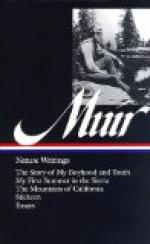The next great flower wonders on which we lavished admiration, not only for beauty of color and size, but for their curious shapes, were the cypripediums, called “lady’s-slippers” or “Indian moccasins.” They were so different from the familiar flowers of old Scotland. Several species grew in our meadow and on shady hillsides,—yellow, rose-colored, and some nearly white, an inch or more in diameter, and shaped exactly like Indian moccasins. They caught the eye of all the European settlers and made them gaze and wonder like children. And so did calopogon, pogonia, spiranthes, and many other fine plant people that lived in our meadow. The beautiful Turk’s-turban (Lilium superbum) growing on stream-banks was rare in our neighborhood, but the orange lily grew in abundance on dry ground beneath the bur-oaks and often brought Aunt Ray’s lily-bed in Scotland to mind. The butterfly-weed, with its brilliant scarlet flowers, attracted flocks of butterflies and made fine masses of color. With autumn came a glorious abundance and variety of asters, those beautiful plant stars, together with goldenrods, sunflowers, daisies, and liatris of different species, while around the shady margin of the meadow many ferns in beds and vaselike groups spread their beautiful fronds, especially the osmundas (O. claytoniana, regalis, and cinnamomea) and the sensitive and ostrich ferns.
Early in summer we feasted on strawberries, that grew in rich beds beneath the meadow grasses and sedges as well as in the dry sunny woods. And in different bogs and marshes, and around their borders on our own farm and along the Fox River, we found dewberries and cranberries, and a glorious profusion of huckleberries, the fountain-heads of pies of wondrous taste and size, colored in the heart like sunsets. Nor were we slow to discover the value of the hickory trees yielding both sugar and nuts. We carefully counted the different kinds on our farm, and every morning when we could steal a few minutes before breakfast after doing the chores, we visited the trees that had been wounded by the axe, to scrape off and enjoy the thick white delicious syrup that exuded from them, and gathered the nuts as they fell in the mellow Indian summer, making haste to get a fair share with the sapsuckers and squirrels. The hickory makes fine masses of color in the fall, every leaf a flower, but it was the sweet sap and sweet nuts that first interested us. No harvest in the Wisconsin woods was ever gathered with more pleasure and care. Also, to our delight, we found plenty of hazelnuts, and in a few places abundance of wild apples. They were desperately sour, and we used to fill our pockets with them and dare each other to eat one without making a face,—no easy feat.
One hot summer day father told us that we ought to learn to swim. This was one of the most interesting suggestions he had ever offered, but precious little time was allowed for trips to the lake, and he seldom tried to show us how. “Go to the frogs,” he said, “and they will give you all the lessons you need. Watch their arms and legs and see how smoothly they kick themselves along and dive and come up. When you want to dive, keep your arms by your side or over your head, and kick, and when you want to come up, let your legs drag and paddle with your hands.”




